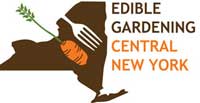Sierra Club
Invasive Species Identification Walk
Nov. 18, 2 pm
|
 | Swallowwort is a common invasive especially harmful to monarch butterflies
|
| |
Invasive Species Identification and Controls
This Sunday walk will be led by Tom Brumbelow, an ESF Graduate Student and member of the NY State Parks team devoted to control of invasives in our Parks.
Learn about the latest techniques to eradicate dangerous invasives, why it is important, how to identify them and get involved. Time to check your own backyard!
Meet at the Nature Center in Clark Reservation
We will learn about invasive species as we hike to various sites in the park where actions are underway for controls.
Dress for trail hiking. Length is about 2 hours. Children and dogs on leash are welcome.
For more information, call 315-492-4745.
|
| Our Habitat Garden |  |
Visit Our Habitat Garden website for information on providing habitat, earth-friendly gardening practices, plants, and various creatures here in Central New York.
|
| HGCNY on Facebook |
As as more of us participate on our Facebook page, this will become a useful resource for asking (and answering!) local HGCNYers' questions about habitat gardening. |
|
Join HGCNY!
|  |
Becoming an official member of HGCNY is easy: just join Wild Ones! When you're a Wild Ones member, you're automatically an official member of HGCNY. |
|
Our Edible Garden
|  | Visit OurEdibleGarden.org to see an example of a Central New York edible garden, the perfect companion to your habitat garden.
|
| Interested in Edible Gardening? | 
|
If you'd like to get information on Edible Gardening CNY, just email John to find out about edible gardening tours and monthly programs. Free and open to the public! |
|
Greetings!

Our November meeting is always a little different. Since we meet the last Sunday of the month, our meeting falls at end of the Thanksgiving weekend, so we're a little more informal. Our November meeting is a good way to wrap up the holiday! This November, we're pleased to be able to show the video Urban & Suburban Meadows, Bringing Meadowscaping to Big and Small Spaces by Catherine Zimmerman, based on the book of the same name. Those on our Board who previewed the video all enjoyed it and thought it was worthwhile. ( View the trailer...)
When: Sunday Nov. 25 at 2:00 pm Where: Liverpool Library ( Directions) Free and open to the public
 | | BEE involved! |
It's Election Time!No, not that one -- our HGCNY election! If you're an official Wild Ones/HGCNY member, you'll receive an email in the next few weeks inviting your participation in our election.
We're very grateful to those who serve on our Board as well as those who participate unofficially in our planning meetings. They're an unusually insightful group of people and always have good suggestions for HGCNY activities! They're also the people you see working at our meetings.
Thank yous go to:
John Allen, Carol Biesemeyer, Peter Huntington, Soule Leiter, Beth Mitchell, Dave Mitchell, Linda Rossiter, and Randi Starmer.
Janet Allen
President, HGCNY
|
|
|
What is a cultivar?
 | | A cultivar of a native aster |
Here's what William Cullina says in his book Wildflowers:
To keep wild and human selected variations separate, the term cultivar was developed. A cultivar is a clone or seed strain selected for a particular trait or traits.
Note that a cultivar can be a variety selected from a native plant, sometimes referred to by the new-ish term 'nativar.'
Scientific botanical names are written in italics with the genus name capitalized and the species name in lower case. The name of the cultivar follows this botanical name, but is not italicized and is enclosed by single quotes.
For example, a cultivar of the native serviceberry is written: Amelanchier canadense 'Glennform.' A popular cultivar of the native river birch is Betula nigra 'Heritage.' If a nursery is careful about how it labels its plants, this is the format that will tip you off that it's a cultivar.
What difference does it make?
Yes, technically these are native plants. But there's no genetic variation, which could come in handy as the climate changes.
And do these cultivars have the habitat properties we expect from the native plant? In at least some cases, no!
For example, the serviceberry cultivar (at least the one I planted) has a nice compact shape--but virtually no berries! This was a real loss for birds (and we've since cut it down).
And no bees visited the aster cultivar, evidently also having been selected for its compact shape. (It can't have been selected for prettier flowers since our New England asters are already spectacular!)
Apparently the native plant from which it was selected may not have had as much nectar as others, or perhaps it lacked the nectar guides bees can see, but human can't. (You can see flowers as bees see them at this NC State website or on Wikipedia.) Or perhaps the cultivar doesn't have the same microtexture of the species -- another flower characteristic recent NIH research has studied which is important to bees, but not to humans.
The bottom line: Cultivars are selected for humans, not for healthy ecosystems nor for the creatures that depend on them.
|
|
Monarch migration progress
 | | Wind map of Sandy from http://hint.fm/wind/ |
Monarchs are beginning to arrive at their winter habitat in Mexico.
Although we in the Northeast had a good population of monarchs this year, it was a different story in the Midwest. Experts expect the overwintering population to be below the historic low of 1.92 hectares recorded in 2009.
Sandy didn't helpSandy's winds weren't favorable to monarchs. As Chip Taylor of Monarch Watch pointed out on Oct. 30, "These conditions are not favorable for the movement of monarchs that still linger in an area from Louisiana to New Jersey. These winds are offshore for a broad area. Monarchs like a tail wind and conditions like these in the past have resulted in monarchs riding these winds to their demise at sea."
You can keep up with the latest weekly news about monarchs at Journey North. |
|
Winter finch forecast
 | | Redpoll visiting CNY in April 2008 |
This year's drought and the resulting forest seed and fruit crop failure (such as berries, pine cones etc.) over a large part of the continent may prompt many bird species to move beyond their usual winter ranges.
eBird has Ron Pittaway's winter finch forecast. Although it's specific to Ontario, it's also relevant to our area. He's predicting the movement of Red and White-winged Crossbills, redpolls, Pine Grosbeaks, and Evening Grosbeaks. (See the report for details about these and other species.)
Not sure what these look like?Cornell's Lab of Ornithology has an excellent resource aptly-named All About Birds. It not only will help you ID birds but will also provide lots of interesting information about them.
And track the birds you see with Project FeederWatch, which is now starting its November to April season! It's suitable for beginning to advanced birdwatchers. Northeastern forestsClimate change will have profound effects on Northeastern forests. The USDA Forest Service has a new report ( available as a free .pdf) that says, "Tree species composition of northeast forests has shifted slowly in response to climate for thousands of years. However, current human-accelerated climate change is much more rapid and it is unclear how forests will respond to large changes in suitable habitat."(See the report or a summary at Science Daily.) |
|
Bees distinguish Monet vs. Picasso!
 | Given a toxic-free habitat, this bumblebee is pollinating apple trees for free!
|
Australian scientists have found that bees can distinguish between paintings by Picasso or Monet. The scientists are studying how bees search for food as well as how humans learn. (Read more and see a video at BBC News...)
Bees and pesticides New research published in the journal Nature has concluded that combined pesticide exposure, including an oft-implicated neonictinoid, affects bees adversely.
(Read more about what science shows at Beyond Pesticides...)
Another study at the Univ. of Minnesota shows that household insecticides may be playing a role in declining bee populations by making bees less resistant to the parasites and pathogens that researchers now believe are likely causes of Colony Collapse Disorder.
Pollinating crops by hand? Due to pesticide use and loss of habitat, farmers in some regions of China are now pollinating their fruit crops by hand. They carry pots of pollen and paintbrushes with which to individually pollinate every flower, and use children to climb up to the highest blossoms. (See photos and read more ...)
Remember:
Bees are responsible for one of every three bites of our food as well as pollinating a large percentage of the world's plants. |
|
|
|
|